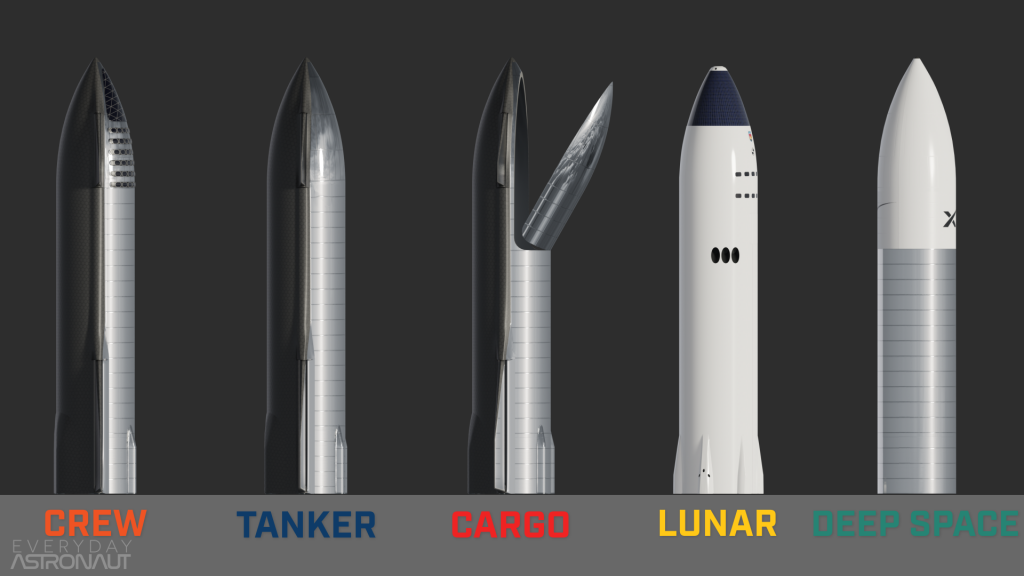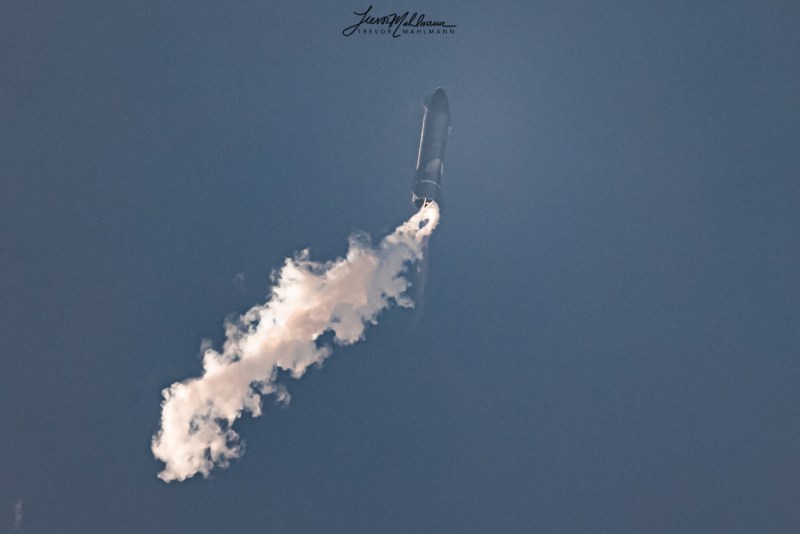Featured image: Trevor Mahlmann
Lift Off Time | March 30, 2021 – ~13:00 UTC | 08:00 CDT |
|---|---|
Mission Name | 10 km Test Flight |
Launch Provider | SpaceX |
Customer | SpaceX |
Rocket | Starship SN11 |
Launch Location | Test Stand B, Boca Chica, Texas, United States |
Payload mass | There is no payload on this test flight |
Where did the satellites go? | There is no payload on this test flight |
Did they attempt to recover the first stage? | Yes. However in the Super Heavy/Starship stack this will be the second stage and will also be recovered. |
Where did the first stage land? | It exploded over the launch complex at around T + 5:50 into flight during Raptor relight. |
Did they attempt to recover the fairings? | There are no fairings on Starship |
Were these fairings new? | There are no fairings on Starship |
How was the weather? | Little to no visibility due to fog. |
This was the: | – 1st flight of SN11 – 3rd flight of a Starship prototype to 10 km – 6th flight of a Starship prototype (excluding three Starhopper hops) – 4th flight of Starship with a nosecone and aerodynamic control surfaces |
Where to watch | Official Replay Everyday Astronaut Replay |
How did it go?
For the 4th time in the Starship program, SpaceX launched and later exploded their next Starship prototype, Serial Number 11 (SN11). Ignition and liftoff was nominal, however engine two experienced problems during ascent. The vehicle then flipped and preformed the belly flop maneuver.
Public information is limited and Elon Musk only mentioned that “…. engine 2 had issues on ascent and didn’t reach operating chamber pressure during landing burn ….”. Shortly after gimbal movement the one engine visibly ignites and SpaceX’s footage cuts out. Early estimations from Declan Murphy at flightclub.io indicate that the vehicle exploded about 600 meters above ground while traveling at 88 meters per second (about 290 feet per second). This resulted in bits and pieces of stainless steel to rain down on the surrounding area.
Starship SN11 Flight Profile
Similarly to the previous prototypes, SN11 flew up to an altitude of around 10 kilometers (~6.2 miles) before performing its belly flop maneuver and falling back down towards the landing pad. SpaceX intentionally shut down its three Raptor engines during ascent and later tried to reignite them during the flip maneuver. Below is a table of each event based on the previous flights of Starship prototypes. Due to the nature of the dynamic countdown leading up to liftoff, these events do not have specific time stamps.
Events Prior and During Launch
| Event | Description |
|---|---|
| Road Closure | The road leading to the pad and beach closes to all non-SpaceX personnel. |
| Flight Termination System (FTS) Pins Removal | The safety pins are removed which arms the FTS. The FTS is a set of C4 charges that explode the vehicle if it were to go off course or have a malfunction. |
| Pad Clear | Everyone, including SpaceX employees must be cleared from the pad and the surrounding area. |
| Recondenser On | This signifies the start of pressurization of tanks on the ground in the tank farm. |
| Ground Tank Clouds | The ground farm has become pressurized and is preparing to load fuel and oxidizer into the vehicle. |
| LOx and CH4 Tank Load | All four tanks on Starship begin receiving their propellants from the ground tanks. This is shown by the frost accumulation on the outside of the vehicle and visible vents. |
| Methane Vent | A vent can be seen from the methane tank on Starship, which depressurizes the tank. |
| Engine Chill | Engine chill is evident when condensation appears from inside the skirt, followed by “Tri-vents” or three vents near each respective Raptor engine closer to liftoff. The engines must be chilled by liquid oxygen before they ignite. |
| Liftoff | The clamps holding down Starship are released after the engines are at desired thrust and the vehicle lifts off from the pad. |
| First Engine Shutdown | On ascent, one engine is shut down intentionally to extend the time they need to reach apogee in order to maximize the time an engine can fire. |
| Second Engine Shutdown | On ascent, a second engine is shut down intentionally to extend the time they need to reach apogee in order to maximize the time an engine can fire. |
| Hover and Third Engine Shutdown | At the target altitude, Starship will hover on one engine before initializing the belly flop and shutting it down shortly after. |
| Belly Flop Maneuver | The vehicle uses its four aerodynamic fin surfaces (two forward, two aft) to turn belly side down and control its descent as it begins to fall back towards the ground. |
| Flip/Engine Relight | At an altitude of approximately 500 meters (~1,600 feet) Starship relights all three Raptor engines as the fins and engines force it to go vertical again. |
| Landing | The two least healthy engines shuts down after correcting for any over rotation as it slowly descends on the landing pad with its landing legs deployed. |
| Depress | After Starship is on the pad, the vehicle will begin to depressurize by venting as a step toward making the vehicle safe for recovery personnel approach. |
What is Starship?
SpaceX is developing their next generation rocket in Boca Chica, Texas, United States. The launch system consists of the first stage “Super Heavy” vehicle, which will boost the second stage “Starship” out of Earth’s atmosphere. When both are fully stacked, they are referred to as “Starship”. After the two separate, Starship, powered by six Raptor engines, will continue to orbit. This could involve staying in Low Earth Orbit (LEO) or moving on to the Moon and eventually Mars.
As of the development of SN11, three previous Starships have flown with aerodynamic surfaces, (SN8, SN9, and SN10) with all three exploding on or shortly after landing. Booster Number 1 (BN1) is currently being built and could be up next in the line of testing.

Starship Internals
Starship uses liquid methane (CH4) as its fuel and liquid oxygen (LOx) as its oxidizer. When the vehicle is vertical, the larger liquid oxygen tank is on the bottom and the smaller liquid methane tank is on the top. The reason for the different sizes in tanks is due to the mixture ratio between methane and liquid oxygen that the Raptor engine requires to run properly. However, Raptor can operate outside of this ratio.
At the very top of the vehicle and in-between the CH4 tank and the LOx tank are the two header tanks. These tanks are required for the unique flip maneuver that Starship does just before landing on the landing pad. When an engine relights, it must not suck in any air. That could result in the loss or damage of an engine. The header tanks are designed to eliminate that, so fuel will always be taken in by the engine while the vehicle is on its side.

Starship Variants
The current Starship launch vehicle is fairly minimal compared to the complex human transport version to be built and flown in the upcoming years. Along with human transportation, Starship also plans to have cargo and tanker versions to perform other various functions.

The crew version of Starship will have the capability to carry humans. The exact number of which is still up for debate, however its capacity will be higher than any other crewed launch vehicle ever built. The tanker appears to be similar to the current version of Starship undergoing testing and development, like SN11. Its main purpose will be to take an extra amount of propellant and transfer it to another Starship already in orbit.
The cargo variant of Starship will carry various types of cargo to a variety of orbits. Current numbers estimate that this variant could take 150 metric tons (330,000 pounds) to Low Earth Orbit (LEO). The lunar and deep space versions are even further out in development but these variants will be able to reach the Moon and the outer planets respectively.
The Raptor Engine
Both Super Heavy and Starship will be powered by various numbers of Raptor engines. The Raptor engines are unique enough themselves and use the Full Flow Staged Combustion Cycle, which makes it one of the most complex engines ever designed and built.

The Raptor engine is still in development, which means that significant and minor changes will occur as the development process continues. One of the more visible changes is the removal of testing hardware which has resulted in the engine plumbing being more compact and streamlined. As the Raptor engine gets farther along in development and SpaceX gathers more data, more changes will be made.
Future Testing
Up next, after the testing of SN11, is SN15, since BN1 will be scrapped, as it has served its purpose as a manufacturing pathfinder. Due to the rapidly changing design and updates of Starship, SN12, 13, and 14 have been canceled and scrapped. SN15 has some major design changes including the new Raptor engines and control surfaces. Construction of the orbital launch complex continues, which is where Super Heavy will be tested and launched from. Following SN15 will most likely be SN16-20, which will have further upgrades including even more heat shield tiles. BN2 is the next Super Heavy prototype expected to be tested by the end of April.





Why is it they need to maximize the time it takes to reach apogee? I’m confused why they need the engines to burn longer?
It is part of the testing of the ever developing Raptor engines and they need to shut engines down because otherwise they will go faster than they are intending to for these test flights.
What is the status of your equipment that went offline turning the crash? Any damage?
Any updates of the vacuum raptor testing? A totally unrelated comment but the people need to know.
Hard to know about this stuff. You’ll hear about it when we do 🙂
I’ll keep an eye out
Has there ever been another full flow, stage combustion engine that wasn’t Raptor? Also, do y’all want to do a virual collab with a Middle School?
Hey is could you include what raptor engines where used? Aka what sn it uses
Hi!!! In SN and BN size of the ch4 and LOX compartment relation. Why do you think ut is bigger de ch4 compartment in relation to LOX compartment un BN than it is in SN.?